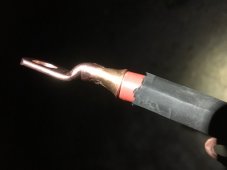Tomthumb62
Solar Wizard
- Joined
- Sep 25, 2022
- Messages
- 1,871
UPDATE: DON'T DO THIS! While this redneck crimp was cheap and worked in a pinch (ha ha), y'all have convinced me this is a bad idea. For a very short-term fix under low loads, probably no problem. But if you intend to push the limit of amps through such a cable and especially if you plan to use this cable/lug over a long term, you risk fire or electrical gremlins. Without all the air gaps inside the lug and cable, oxidation can creep in and compromise the ability for amps to get from point A to B. Don't do what I did. This post was originally under a different forum, but a mod wisely moved it to the Up in Smoke one.
The consensus of this thread to do a crimp the best way is to use a $40-80 hex-style hydraulic crimp tool. They come with different dies, use the correct size for the size of cabling you're doing. HF has one for about $70 and this $50 one was recommended on this thread. Or go pro for the $174 one.
Now back to my original low-budget route, I bet with a good heavy bench vice and this $16 die set, you could do it. But it might be more challenging to get it all to fit properly in a bench vice, something could easily slip - some tape or a helper set of hands would do the trick. In fact, I just ordered these dies and will be returning the hammer crimper. I'll update my post after I try it out. Business opportunity here - someone could make a hammer crimper but uses these kind of dies instead, cost could be what? $20-25? For someone like me who is only going to occasionally make such crimps, it makes more sense than having a more expensive tool.
Original post:
I didn’t need to buy another $40 tool for two crimps, so I made my own hammer crimper. Cost $0.
I needed to crimp new copper lugs to 1AWG cable, so I did this:

Slid heat shrink on first. Placed lug onto cable. Taped two small screws onto top and bottom of lug using electrical tape. Placed this jig onto a flat rock and used a sledgehammer head I had sitting around but a heavy rock would do or a hammer. One or two solid taps on each side put a nice crimp on. Tap right onto the top screw. Make sure the two screws are aligned with each other so you get an even crimp.


Did a good crimp

The consensus of this thread to do a crimp the best way is to use a $40-80 hex-style hydraulic crimp tool. They come with different dies, use the correct size for the size of cabling you're doing. HF has one for about $70 and this $50 one was recommended on this thread. Or go pro for the $174 one.
Now back to my original low-budget route, I bet with a good heavy bench vice and this $16 die set, you could do it. But it might be more challenging to get it all to fit properly in a bench vice, something could easily slip - some tape or a helper set of hands would do the trick. In fact, I just ordered these dies and will be returning the hammer crimper. I'll update my post after I try it out. Business opportunity here - someone could make a hammer crimper but uses these kind of dies instead, cost could be what? $20-25? For someone like me who is only going to occasionally make such crimps, it makes more sense than having a more expensive tool.
Original post:
I didn’t need to buy another $40 tool for two crimps, so I made my own hammer crimper. Cost $0.
I needed to crimp new copper lugs to 1AWG cable, so I did this:

Slid heat shrink on first. Placed lug onto cable. Taped two small screws onto top and bottom of lug using electrical tape. Placed this jig onto a flat rock and used a sledgehammer head I had sitting around but a heavy rock would do or a hammer. One or two solid taps on each side put a nice crimp on. Tap right onto the top screw. Make sure the two screws are aligned with each other so you get an even crimp.


Did a good crimp

Last edited:




